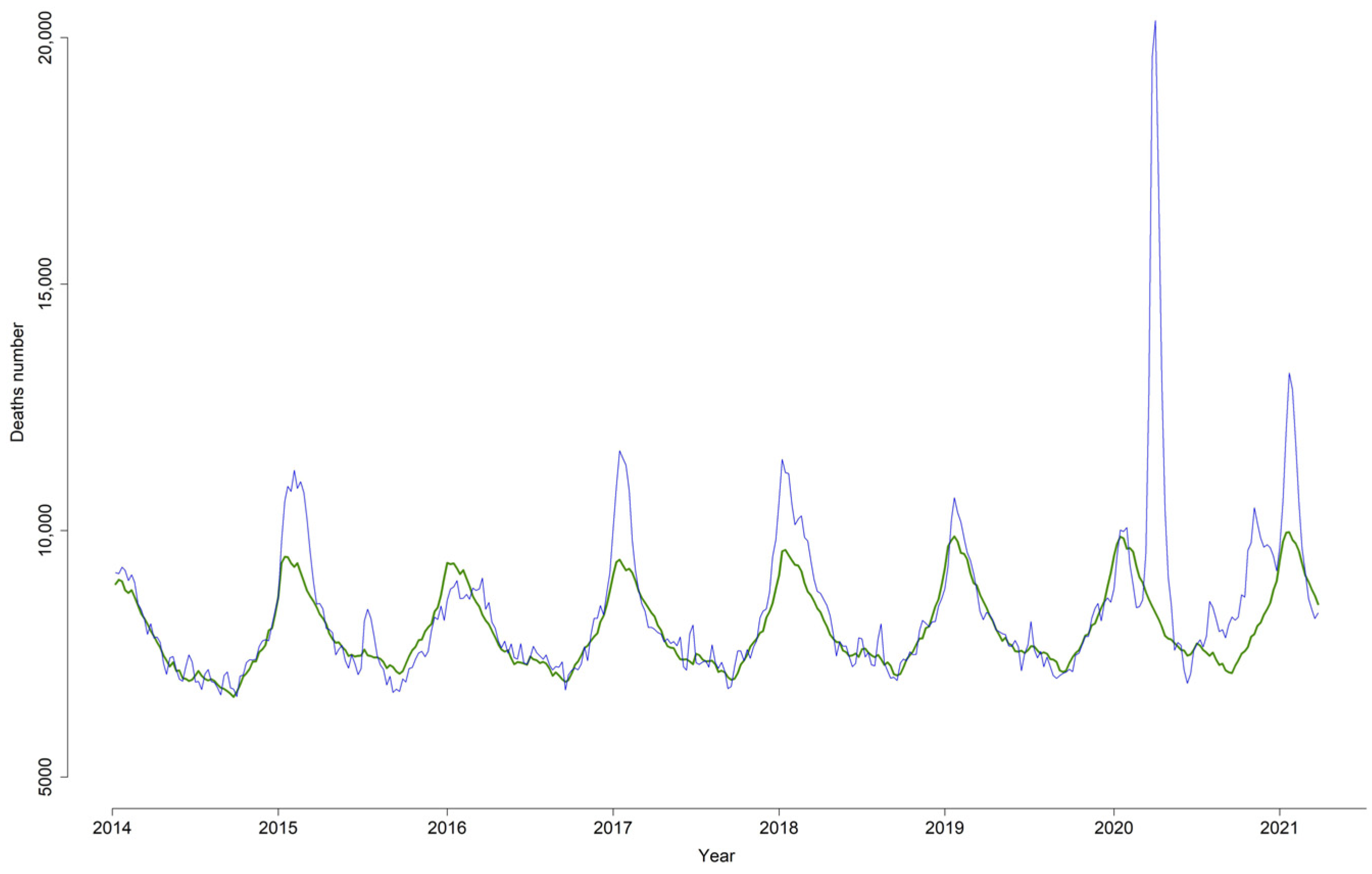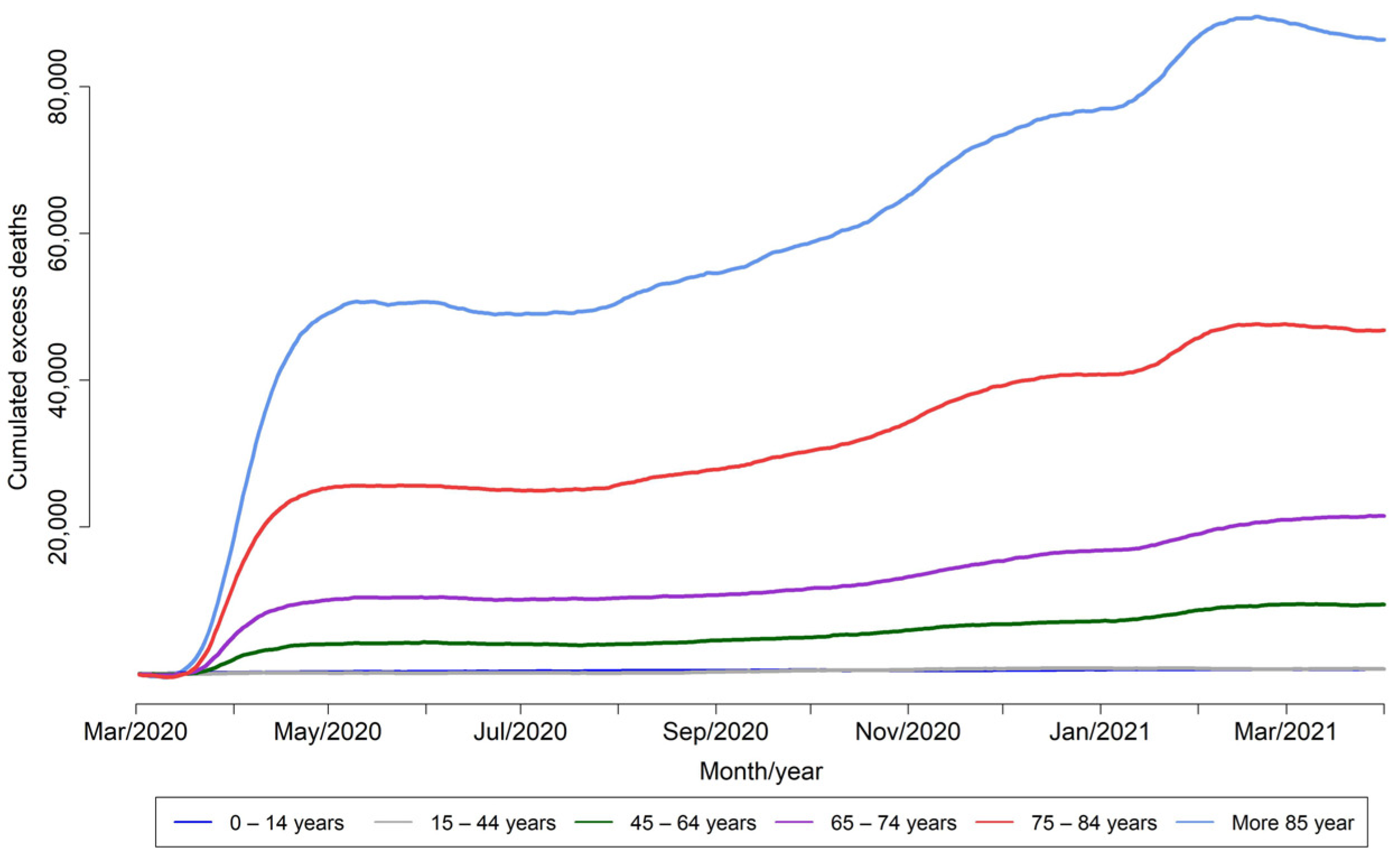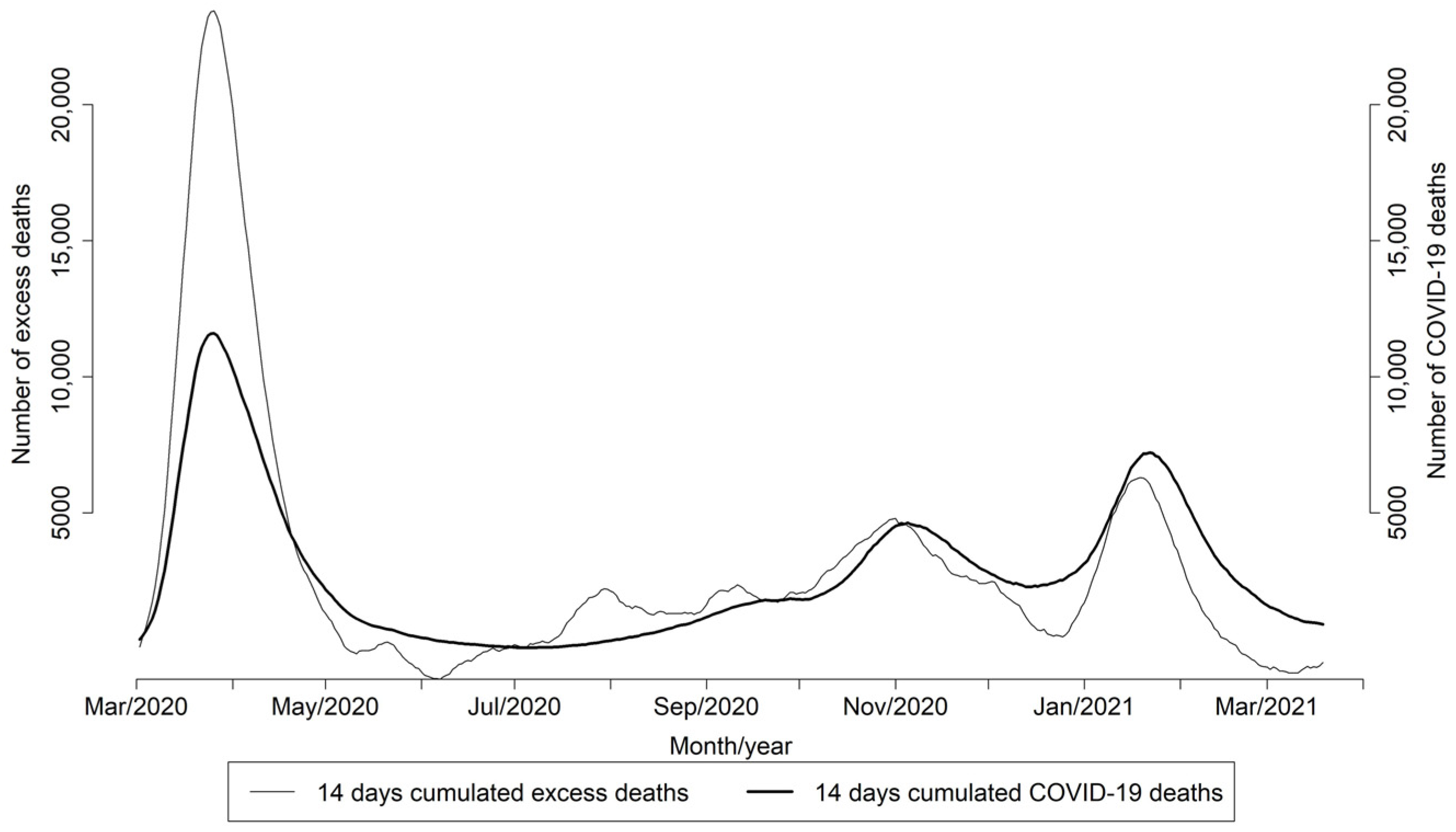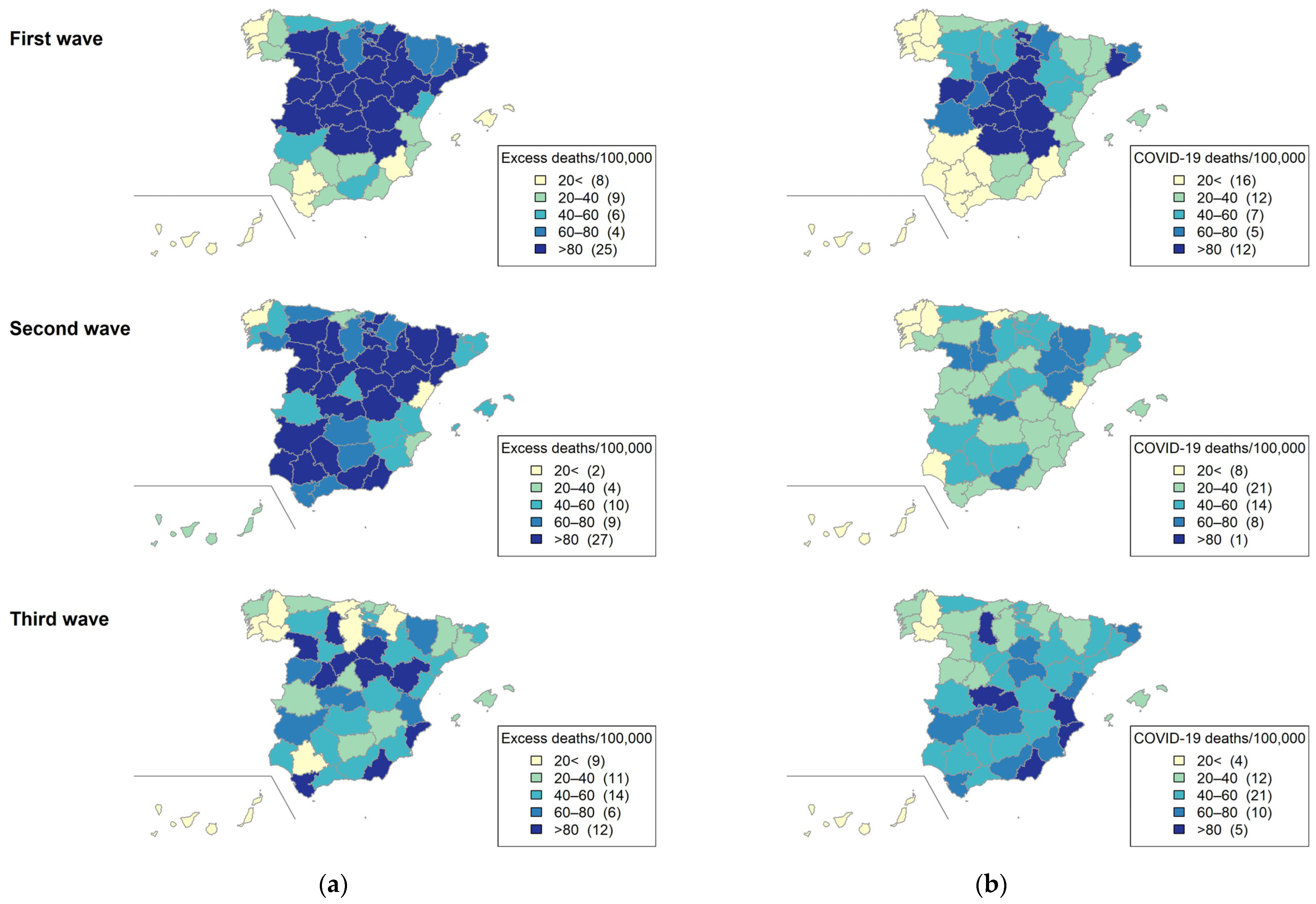The Impact of COVID-19 on Mortality in Spain: Monitoring Excess Mortality (MoMo) and the Surveillance of Confirmed COVID-19 Deaths
Abstract
1. Introduction
2. Materials and Methods
2.1. Data Sources
2.2. Statistical Methods
3. Results
4. Discussion
5. Conclusions
Supplementary Materials
Author Contributions
Funding
Institutional Review Board Statement
Informed Consent Statement
Data Availability Statement
Conflicts of Interest
References
- Vestergaard, L.S.; Nielsen, J.; Richter, L.; Schmid, D.; Bustos, N.; Braeye, T.; Denissov, G.; Veideman, T.; Luomala, O.; Möttönen, T.; et al. Excess all-cause mortality during the COVID-19 pandemic in Europe—Preliminary pooled estimates from the EuroMOMO network, March to April 2020. Eurosurveillance 2020, 25, 2001214. [Google Scholar] [CrossRef]
- Scortichini, M.; Schneider dos Santos, R.; De’Donato, F.; De Sario, M.; Michelozzi, P.; Davoli, M.; Masselot, P.; Sera, F.; Gasparrini, A. Excess mortality during the COVID-19 outbreak in Italy: A two-stage interrupted time-series analysis. Int. J. Epidemiol. 2020, 49, 1909–1917. [Google Scholar] [CrossRef] [PubMed]
- Nogueira, P.J.; de Araújo Nobre, M.; Nicola, P.J.; Furtado, C.; Carneiro, A.V. Excess Mortality Estimation during the COVID-19 Pandemic: Preliminary Data from Portugal. Acta Médica Port. 2020, 33, 376–383. [Google Scholar] [CrossRef] [PubMed]
- Sinnathamby, M.A.; Whitaker, H.; Coughlan, L.; Lopez Bernal, J.; Ramsay, M.; Andrews, N. All-cause excess mortality observed by age group and regions in the first wave of the COVID-19 pandemic in England. Euro. Surveill. Bull. Eur. Sur. Mal. Transm. Eur. Commun. Dis. Bull. 2020, 25, 2001239. [Google Scholar] [CrossRef] [PubMed]
- Weinberger, D.M.; Chen, J.; Cohen, T.; Crawford, F.W.; Mostashari, F.; Olson, D.; Pitzer, V.E.; Reich, N.G.; Russi, M.; Simonsen, L.; et al. Estimation of Excess Deaths Associated With the COVID-19 Pandemic in the United States, March to May 2020. JAMA Intern. Med. 2020, 180, 1336–1344. [Google Scholar] [CrossRef] [PubMed]
- Krieger, N.; Chen, J.T.; Waterman, P.D. Excess mortality in men and women in Massachusetts during the COVID-19 pandemic. Lancet 2020, 395, 1829. [Google Scholar] [CrossRef]
- VanderWeele, T.J. Challenges Estimating Total Lives Lost in COVID-19 Decisions: Consideration of Mortality Related to Unemployment, Social Isolation, and Depression. JAMA 2020, 324, 445–446. [Google Scholar] [CrossRef] [PubMed]
- Modig, K.; Ahlbom, A.; Ebeling, M. Excess mortality from COVID-19: Weekly excess death rates by age and sex for Sweden and its most affected region. Eur. J. Public Health 2021, 31, 17–22. [Google Scholar] [CrossRef] [PubMed]
- León-Gómez, I.; Delgado-Sanz, C.; Jiménez-Jorge, S.; Flores, V.; Simón, F.; Gómez-Barroso, D.; Larrauri, A.; Ontañón, S.D.M. Exceso de mortalidad relacionado con la gripe en España en el invierno de 2012. Gac. Sanit. 2015, 29, 258–265. [Google Scholar] [CrossRef] [PubMed][Green Version]
- MoMo Panel: Notification. Available online: https://momo.isciii.es/public/momo/dashboard/momo_dashboard.html#notificacion (accessed on 1 July 2021).
- Eurostat: Revision of the European Standard Population. Available online: https://ec.europa.eu/eurostat/documents/3859598/5926869/KS-RA-13-028-EN.PDF.pdf/e713fa79-1add-44e8-b23d-5e8fa09b3f8f?t=1414782757000 (accessed on 1 July 2021).
- Islam, N.; Shkolnikov, V.M.; Acosta, R.J.; Klimkin, I.; Kawachi, I.; Irizarry, R.A.; Alicandro, G.; Khunti, K.; Yates, T.; Jdanov, D.A.; et al. Excess deaths associated with covid-19 pandemic in 2020: Age and sex disaggregated time series analysis in 29 high income countries. BMJ 2021, 373, n1137. [Google Scholar] [CrossRef] [PubMed]
- Kontopantelis, E.; Mamas, M.A.; Deanfield, J.; Asaria, M.; Doran, T. Excess mortality in England and Wales during the first wave of the COVID-19 pandemic. J. Epidemiol. Community Health 2021, 75, 213–223. [Google Scholar] [CrossRef]
- Sanmarchi, F.; Golinelli, D.; Lenzi, J.; Esposito, F.; Capodici, A.; Reno, C.; Gibertoni, D. Exploring the Gap Between Excess Mortality and COVID-19 Deaths in 67 Countries. JAMA Netw. Open 2021, 4, 2117359. [Google Scholar] [CrossRef] [PubMed]
- Working group for the surveillance and control of COVID-19 in Spain. The first wave of the COVID-19 pandemic in Spain: Characterisation of cases and risk factors for severe outcomes, as at 27 April 2020. Eurosurveillance 2020, 25, 2001431. [Google Scholar]
- Ministry of Health and Carlos III Institute of Health. Strategy for Early Detection, Surveillance and Control of COVID-19. 5 July Update. Available online: https://www.mscbs.gob.es/profesionales/saludPublica/ccayes/alertasActual/nCov/documentos/COVID19_Estrategia_vigilancia_y_control_e_indicadores.pdf (accessed on 1 July 2021).
- Instituto de Salud Carlos III. Situación de COVID-19 en España. Informe nº 98.29 de Septiembre de 2021. Available online: https://www.isciii.es/QueHacemos/Servicios/VigilanciaSaludPublicaRENAVE/EnfermedadesTransmisibles/Documents/INFORMES/Informes%20COVID-19/INFORMES%20COVID-19%202021/Informe%20n%C2%BA%2098%20Situaci%C3%B3n%20de%20COVID-19%20en%20Espa%C3%B1a%20a%2029%20de%20septiembre%20de%202021.pdf (accessed on 11 May 2021). (In Spanish).
- Faust, J.S.; del Rio, C. Assessment of Deaths From COVID-19 and From Seasonal Influenza. JAMA Intern. Med. 2020, 180, 1045–1046. [Google Scholar] [CrossRef] [PubMed]
- Nielsen, J.; Vestergaard, L.S.; Richter, L.; Schmid, D.; Bustos, N.; Asikainen, T.; Trebbien, R.; Denissov, G.; Innos, K.; Virtanen, M.J.; et al. European all-cause excess and influenza-attributable mortality in the 2017/18 season: Should the burden of influenza B be reconsidered? Clin. Microbiol. Infect. 2019, 25, 1266–1276. [Google Scholar] [CrossRef] [PubMed]
- Aburto, J.M.; Kashyap, R.; Schöley, J.; Angus, C.; Ermisch, J.; Mills, M.C.; Dowd, J.B. Estimating the burden of the COVID-19 pandemic on mortality, life expectancy and lifespan inequality in England and Wales: A population-level analysis. J. Epidemiol. Community Health 2021, 75, 735–740. [Google Scholar] [CrossRef] [PubMed]
- Toulemon, L.; Barbieri, M. The mortality impact of the August 2003 heat wave in France: Investigating the ‘harvesting’ effect and other long-term consequences. Popul. Stud. 2008, 62, 39–53. [Google Scholar] [CrossRef] [PubMed]
- MoMo Panel. Available online: https://momo.isciii.es/public/momo/dashboard/momo_dashboard.html (accessed on 1 July 2021).




| Period | Age Group | MoMo Excess Deaths (N) | COVID-19 Deaths (N) | Ratio MoMo/COVID-19 Deaths |
|---|---|---|---|---|
| First wave: 10 March 2020 21 June 2020 | 0–14 | 127 | 205 | 0.6 |
| 15–44 | 129 | 214 | 0.6 | |
| 45–64 | 2064 | 2280 | 0.9 | |
| 65–74 | 5283 | 4391 | 1.2 | |
| 75–84 | 12,711 | 9168 | 1.4 | |
| Older–85 | 24,730 | 13,190 | 1.9 | |
| all | 44,583 | 29,628 | 1.5 | |
| Second wave: 22 June 2020 6 December 2020 | 0–14 | 133 | 204 | 0.7 |
| 15–44 | 362 | 147 | 2.5 | |
| 45–64 | 1336 | 1528 | 0.9 | |
| 65–74 | 3074 | 2451 | 1.3 | |
| 75–84 | 7330 | 5797 | 1.3 | |
| Older–85 | 12,693 | 9869 | 1.3 | |
| all | 24,373 | 20,109 | 1.2 | |
| Third wave: 7 December 2020 14 March 2021 | 0–14 | 37 | 174 | 0.2 |
| 15–44 | 39 | 178 | 0.2 | |
| 45–64 | 1243 | 2116 | 0.6 | |
| 65–74 | 2821 | 3848 | 0.7 | |
| 75–84 | 3610 | 7806 | 0.5 | |
| Older–85 | 6291 | 11,571 | 0.5 | |
| all | 14,040 | 25,740 | 0.5 | |
| Total period | all | 82,996 | 75,477 | 1.1 |
| Autonomous Communities | MoMo Excess Deaths (N) | COVID-19 Deaths (N) | Ratio MoMo/COVID-19 Deaths |
|---|---|---|---|
| Andalucía | 20,828 | 9630 | 2.2 |
| Aragón | 7048 | 3437 | 2.1 |
| Ppdo. de Asturias | 4097 | 1951 | 2.1 |
| Illes Balears | 1091 | 829 | 1.3 |
| Canarias | −667 | 741 | −0.9 |
| Cantabria | 267 | 560 | 0.5 |
| Castilla-La Mancha | 15,105 | 5857 | 2.6 |
| Castilla y León | 16,173 | 6729 | 2.4 |
| Cataluña | 32,794 | 14,164 | 2.3 |
| C. Valenciana | 15,443 | 7303 | 2.1 |
| Extremadura | 4774 | 1777 | 2.7 |
| Galicia | 2063 | 2378 | 0.9 |
| C. Madrid | 41,887 | 15,139 | 2.8 |
| Región de Murcia | 2648 | 1590 | 1.7 |
| C. Foral de Navarra | 2106 | 1167 | 1.8 |
| País Vasco | 6308 | 4281 | 1.5 |
| La Rioja | 1483 | 762 | 1.9 |
| Ceuta | 665 | 112 | 5.9 |
| Melilla | 356 | 95 | 3.7 |
| Year | MoMo Excess Deaths (N) | EuroMOMO Excess Deaths (N) |
|---|---|---|
| 2015 | 8793 | 34,411 |
| 2016 | 4431 | 17,289 |
| 2017 | 16,121 | 28,543 |
| 2018 | 13,792 | 28,422 |
| 2019 | 201 | 16,098 |
| 2020 | 68,860 | 81,821 |
Publisher’s Note: MDPI stays neutral with regard to jurisdictional claims in published maps and institutional affiliations. |
© 2021 by the authors. Licensee MDPI, Basel, Switzerland. This article is an open access article distributed under the terms and conditions of the Creative Commons Attribution (CC BY) license (https://creativecommons.org/licenses/by/4.0/).
Share and Cite
León-Gómez, I.; Mazagatos, C.; Delgado-Sanz, C.; Frías, L.; Vega-Piris, L.; Rojas-Benedicto, A.; Larrauri, A. The Impact of COVID-19 on Mortality in Spain: Monitoring Excess Mortality (MoMo) and the Surveillance of Confirmed COVID-19 Deaths. Viruses 2021, 13, 2423. https://doi.org/10.3390/v13122423
León-Gómez I, Mazagatos C, Delgado-Sanz C, Frías L, Vega-Piris L, Rojas-Benedicto A, Larrauri A. The Impact of COVID-19 on Mortality in Spain: Monitoring Excess Mortality (MoMo) and the Surveillance of Confirmed COVID-19 Deaths. Viruses. 2021; 13(12):2423. https://doi.org/10.3390/v13122423
Chicago/Turabian StyleLeón-Gómez, Inmaculada, Clara Mazagatos, Concepción Delgado-Sanz, Luz Frías, Lorena Vega-Piris, Ayelén Rojas-Benedicto, and Amparo Larrauri. 2021. "The Impact of COVID-19 on Mortality in Spain: Monitoring Excess Mortality (MoMo) and the Surveillance of Confirmed COVID-19 Deaths" Viruses 13, no. 12: 2423. https://doi.org/10.3390/v13122423
APA StyleLeón-Gómez, I., Mazagatos, C., Delgado-Sanz, C., Frías, L., Vega-Piris, L., Rojas-Benedicto, A., & Larrauri, A. (2021). The Impact of COVID-19 on Mortality in Spain: Monitoring Excess Mortality (MoMo) and the Surveillance of Confirmed COVID-19 Deaths. Viruses, 13(12), 2423. https://doi.org/10.3390/v13122423






